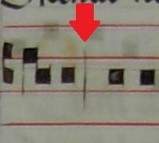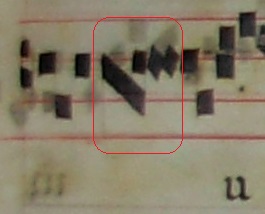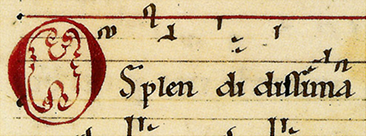6.1 Overview of the Neumes Module6.1.1 Basic four elements6.2 Neumes Module Background6.3 Neume Notation and MEI6.4 Samples of MEI encodings6.4.1 Elements6.4.2 Neume component attributes6.4.3 Custos attributes6.4.4 Episema attributes6.4.5 Liquescent attributes6.4.6 Old Hispanic tick attributes6.4.7 Quilisma attribute6.4.8 Significative letters attribute6.4.9 Note6.4.10 Basic Encoding – Syllable6.4.11 Manuscripts6.5 Bibliographic References
6Repertoire: Neume Notation
This chapter describes the elements, model classes, and attribute classes that are part of the MEI.neumes module.
6.1Overview of the Neumes Module
The MEI Neumes Module represents the community’s attempt to create a standardized set of rules that encapsulate in a logical, systematic, and unequivocal way the musical information represented and conveyed by Western European neumatic notations (beginning with the late ninth century and continuing to the printed books of the twentieth). Most neume notation is used to set music to an existing text. The syllable is the fundamental unit of structure, with the neumes themselves serving as a means of “sonifying” the text. A syllable may be expressed via one or more neumes, with the particular neume shape chosen depending on the pitch contour that is being employed and the desired interpretation.
The `syllable` element is used as the primary organizational element for neume notation within a `layer` element. Within `syllable`, the `syl` element defined in the `MEI.shared` module is used for encoding the textual content, while the `neume` and `nc` elements are used to encode the neumes themselves. Within these Neumes Module elements, other standard MEI mechanisms are available to accommodate, for example, editorial or critical markup.
6.1.1Basic four elements
The following four elements are the fundamental components of the Neumes Module:
Neume notation can be thought of as "neumed text". Therefore, the syllable element provides high-level organization in this repertoire.
(syllable) – Individual lyric syllable.

| Connected | Non-connected |
 |
 |
Sign representing a single pitched event, although the exact pitch may not be known. Examples of neume components are:
| Example 1 | Example 2 | Example 3 |
 |
 |
 |
6.2Neumes Module Background
Neume encoding in MEI was initially developed as part of the Hildegard von Bingen project at the University of Tübingen. MEI was chosen as the basic representation format after a comparison of existing music encoding formats. The initial work on this module was performed by Gregor Schräder (Ein XML-Datenformat zur Repräsentation kritischer Musikedition unter besonderer Berücksichtigung von Neumennotation), supervised by Prof. Stefan Morent. Since 2012 a group of scholars has been working on the development of a new version of the MEI schema for neume notations (Ichiro Fujinaga, Jennifer Bain, Debra Lacoste, Kate Helsen, and Inga Behrendt). Afterwards, other chant scholars joined the group bringing further expertise on other kinds of early music notations (namely Elsa De Luca, Alessandra Ignesti, and Sarah A. Long).
6.3Neume Notation and MEI
There are four main challenges in encoding Western European early music. The first relates to the fact that early notation was just a mnemonic aid that helped the readers to recall the music they already knew by heart and, as such, it conveys only partial musical information (Bain, Behrendt, & Helsen 2014; Helsen, Behrendt, & Bain 2017). Indeed, it is only with the invention of staff lines in the eleventh century that the system of musical transmission gradually changed, relying more on the written record rather than on orality. The second challenge refers to the existence of different regional styles of early notation; early-music manuscripts display a great graphical variety of musical signs, which include both neumes and other notational elements conveying further musical information (e.g., significative letters, Old Hispanic ticks, etc.). Thirdly, some of those regional notational styles occasionally share graphically similar shapes; these similar shapes within the different notational styles are understood by modern scholars to represent the same, a similar, or even a different musical meaning. Finally, while on occasion the neume shapes appear to mirror graphically the musical characteristics of the sound being represented (e.g., pen-stroke going up = rising melody), in many instances it is generally understood that the meaning attached to the neumes (or the other notational elements) may not be so straight-forward, but instead was ruled by conventions shared by the people who knew orally the musical repertory being fixed in written form by means of notation.
What do these challenges entail for modern encoders?
Firstly, sometimes we have to deal with written signs whose meaning is obscure to us and, while we can infer the meaning of some of those signs from the study of later manuscripts with the same melodies and a more precise notation, in other cases we need to turn to music palaeographers who examine the recurrence of those written signs and the context where they were used. By analysing scribal hands in particular manuscripts, palaeographers can often work out if a written sign is a meaningless scribal variant or a graphical feature conveying musical meaning to the medieval reader. Secondly, since a neume shape could either mirror on the page the aural event or bear some other musical meaning attached by convention, the encoding sometimes relies on the visual level or on the semantic level, and this distinction has to be made on a case-by-case basis. Moreover, since the same written sign could have multiple interpretations according to the style of notation where it was employed, it is crucial to be aware of the conventions of each regional notational alphabet in order to capture the musical information conveyed by that sign in the contexts where it is found.
See two examples of shapes found in different regional styles that are not captured with the same encoding:
Example 1
St Gall notation Oriscus (one-note ornamental neume). The oriscus is the middle note of a three-note
raising gesture (commonly called salicus in the literature).

Old Hispanic notation: Two-note downward melodic gesture.

Example 2
Old Hispanic notation: Four-note neutral-low-high-low melodic gesture.

Aquitanian notation: Three-note rising neume with oriscus on the second note.

A further complication is that while the music encoding aims to narrow down and capture the meaning of the neumes in a logical and coherent system, occasionally the significance of some neumes is under debate (e.g., <quilisma>) and, despite its aim for accuracy, the encoding must remain open for future interpretations. From all these challenges has arisen the need for an early music encoding standardisation, that is, a set of rules that work for the description of any neume across all early notations regardless of the different methodologies applied to the study of individual notations and their idiosyncrasies.
Broadly speaking, Western early notations belong to two main categories. On one side we have notations where two or more notes were represented by a single pen-stroke, while on the other side there are notations where the notes are graphically separated by means of discrete dots or short pen-strokes. These distinctions have been described even within single notational styles as gapped or not gapped (Behrendt, Bain, & Helsen 2017). To date, the MEI Neumes Module has been tested mainly on square notations and stroke notations (St. Gall, Old Hispanic, etc.), but also on Aquitanian point-notation.
6.4Samples of MEI encodings
6.4.1Elements
<neume> and <nc> are the most common elements used in the MEI Neumes module. In the following examples we can see how these elements are used to describe sung gestures of 1, 2, and 4 notes in square notation.
| One pitch - Staff notation. Example A |
 |
| One pitch - Staff notation. Example B |
 |
| Two pitches - Staff notation |
 |
| Four pitches - Staff notation |
 |
In addition to <neume> and <nc> the following elements are also frequently used in the MEI Neumes Module: <custos>, <episema>, <hispanTick>, <liquescent>, <ncGrp>, <oriscus>, <quilisma>, <signifLet>, <strophicus>. Note that <nc>, <episema>, <hispanTick>, and <signifLet> are <neume> elements. Instead <oriscus>, <liquescent>, <quilisma>, and <strophicus> are elements that must be part of a <nc> element. The <custos> is an element that is encoded inside the <syl> element. Furthermore, there are many other elements such as Editorial and Metadata elements that are not specific to Neumes and are not listed here.
<custos>: to indicate a symbol placed at the end of a line of music to indicate the first note of the next line. Sometimes called a "direct" (see MEI encoding of <custos> below).
<divLine>: to indicate pause between neumes

<episema>: to indicate an episema (see MEI encoding of <episema> below).

<hispanTick>: to indicate Old Hispanic ticks (see MEI encoding of <hispanTick> below).

<liquescent>: to indicate a liquescent (see MEI encoding of <liquescent> neumes below).

<ncGrp>: to indicate multiple <nc>s.
<oriscus>: to indicate an oriscus.
| ORISCUS - Square notation |
 |
| ORISCUS - St Gall notation |
 |
<quilisma>: to indicate a quilisma (see MEI encoding of <quilisma> below).

<signifLet>: element indicates significative letter(s) attached to a <neume> or a <nc> (see MEI encoding of <signifLet> below).

<strophicus>: to indicate a strophicus
| STROPHICUS - Square notation |
 |
6.4.2Neume component attributes
| GAPPED CONNECTION - Old Hispanic notation |
 |
| LOOPED CONNECTION - Old Hispanic notation |
 |
| EXTENDED CONNECTION - Old Hispanic notation |
 |
Nota bene: the following neume has a similar shape but the neumatic connection is not extended.
| NON-EXTENDED CONNECTION - Old Hispanic notation |
 |
| CURVE - Old Hispanic notation |
 |
| ANGLED - Old Hispanic notation |
 |
| HOOK – Old Hispanic notation |
 |
| RELATIVE LENGTH – Old Hispanic notation. Example A |
 |
| RELATIVE LENGTH – Old Hispanic notation. Example B |
 |
| TILT – Old Hispanic / St Gall notation |
 |
| S-SHAPE – Old Hispanic notation |
 |
| S-SHAPE – St Gall notation |
 |
6.4.3Custos attributes
| CUSTOS - Staff notation |
 |
| CUSTOS - Late Aquitanian notation |
 |
| CUSTOS - Aquitanian notation |
 |
| CUSTOS - Aquitanian notation |
 |
| CUSTOS - Aquitanian notation |
 |
Nota bene: in the last example we can read the exact pitch of the custos because the lozenged punctum (placed one step below the line) signals the lower note of the semitone E-F. This information, combined with the identification of the finalis of the piece, allows us to decipher the mode of this piece, that is the 4th.
6.4.4Episema attributes
| EPISEMA – Staff notation |
 |
| EPISEMA - St Gall notation. Example A |
 |
| EPISEMA - St Gall notation. Example B |
 |
| EPISEMA - St Gall notation. Example C |
 |
6.4.5Liquescent attributes
| LIQUESCENT - Staff notation. Example A |
 |
| LIQUESCENT - Staff notation. Example B |
 |
| LIQUESCENT - Aquitanian notation |
 |
6.4.6Old Hispanic tick attributes
| HISPAN TICK - Old Hispanic notation. The following encoding refers to the neume signalled by the arrow on the left. |
 |
6.4.7Quilisma attribute
| QUILISMA - Staff notation |
 |
| QUILISMA - Old Hispanic notation |
 |
6.4.8Significative letters attribute
| SIGNIFICATIVE LETTERS - St Gall notation |
 |
6.4.9Note
Other articulation marks such as ictus, circulus, semicirculus, accentus, and other fonts in SMuFL can be encoded using: glyph.auth, glyph.name, glyph.num, and glyph.uri.
6.4.10Basic Encoding – Syllable
The following example illustrates the MEI encoding of the opening of Hildegarde’s “O Splendidissima Gemma” with the text “O splendidissima”. This example provides the basic MEI skeleton to have a valid MEI file and it may be used for reference for scholars willing to start encoding early music (and its text) in MEI. Information about the <staff> has been omitted for brevity, but it was originally encoded on a 5-line staff with two clefs, a “C” and a “F” on lines 5 and 3, respectively.

6.4.11Manuscripts
Samples of MEI of St Gall notation are taken from the winter volume of the so-called ”Hartker Antiphonary” CH-SGs Cod. Sang. 390.
Samples of MEI of Old Hispanic notation are taken from the ”León Antiphoner” E-L MS 8.
Samples of MEI of Aquitanian notation are taken from sources on the Portuguese Early Music Database.
6.5Bibliographic References
Bain, Jennifer, Inga Behrendt, and Kate Helsen. 2014. “Linienlose Neumen und ihre Repräsentation mit MEI Schema, Herausforderungen in der Arbeit im Optical Neume Recognition Project (ONRP).” Digitale Rekonstruktionen mittelalterlicher Bibliotheken. Edited by Sabine Philippi and Philipp Vanscheidt. Trierer Beiträge zu den historischen Kulturwissenschaften 12: 119–32.
Behrendt, Inga, Jennifer Bain, and Kate Helsen. 2017. “MEI Kodierung der frühesten Notation in linienlosen Neumen.” Kodikologie und Paläographie im Digitalen Zeitalter 4 / Codicology and Palaeography in the Digital Age. Vol. 4. Edited by Hannah Busch, Franz Fischer, and Patrick Sahle, with the cooperation of Philip Hegel and Celiz Krause, Norderstedt 2016. Köln: Institut für Dokumentologie und Editorik e.V, 2017, 281–96.
De Luca, Elsa, Jennifer Bain, Inga Behrendt, Ichiro Fujinaga, Kate Helsen, Alessandra Ignesti, Debra Lacoste, and Sarah Long. 2019. ”Cantus Ultimus’ MEI Neume Module and its Interoperability Across Chant Notations”. Music Encoding Conference, Vienna.
De Luca, Elsa, Jennifer Bain, Inga Behrendt, Ichiro Fujinaga, Kate Helsen, Alessandra Ignesti, Debra Lacoste, and Sarah Long. “Capturing Early Notations in MEI: The Case of Old Hispanic Neumes”. Musiktheorie-Zeitschrift für Musikwissenschaft 2, 2019: 229-49.
Helsen, Kate, Inga Behrendt, and Jennifer Bain. 2017. “A Morphology of Medieval Notations in the Optical Neume Recognition Project.” Arti musices: Croatian Musicological Review 48/2: 241–266.
MEI Guidelines v4, ch. 6: Neume Notation introducing <nc> as “neume component”.